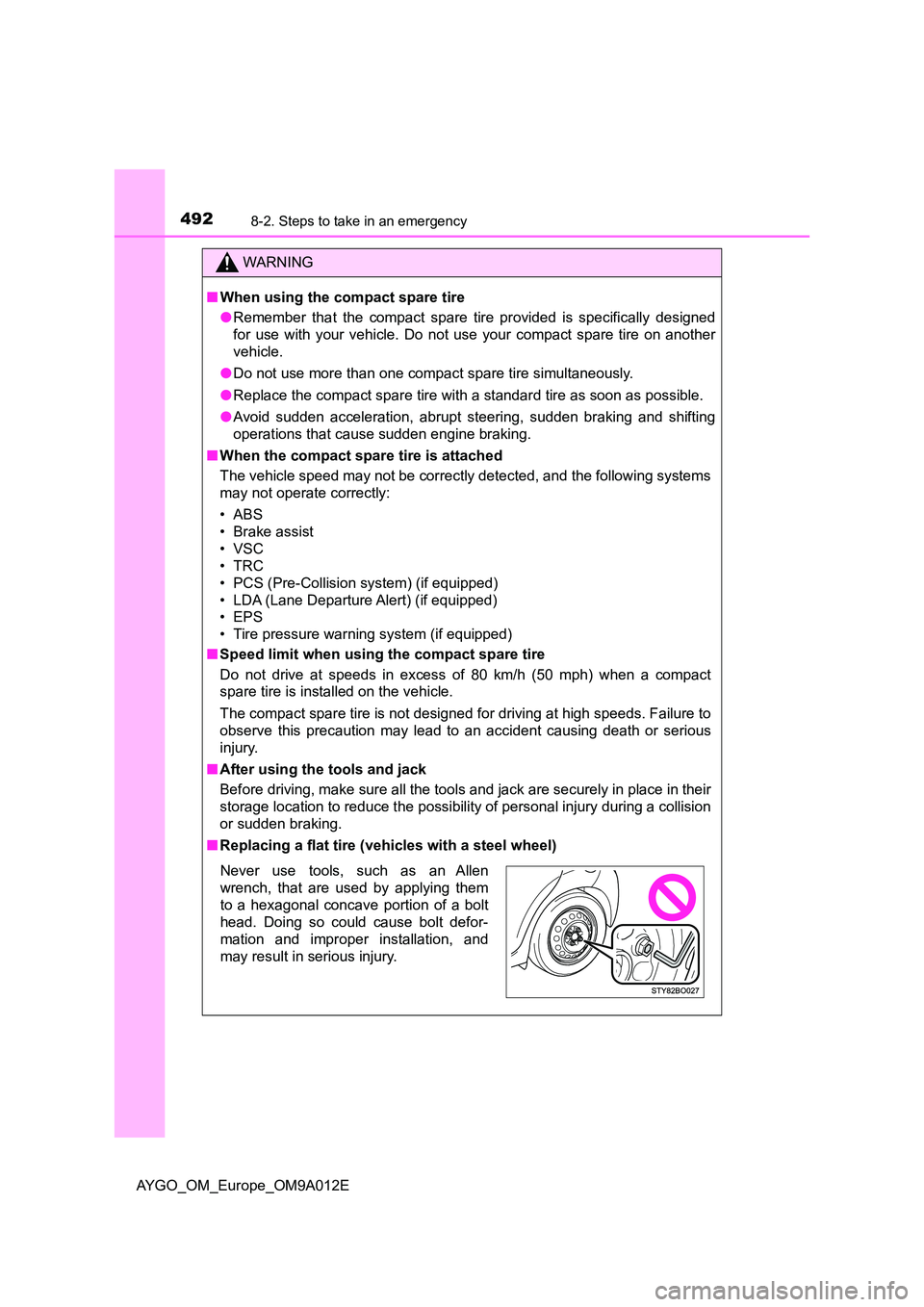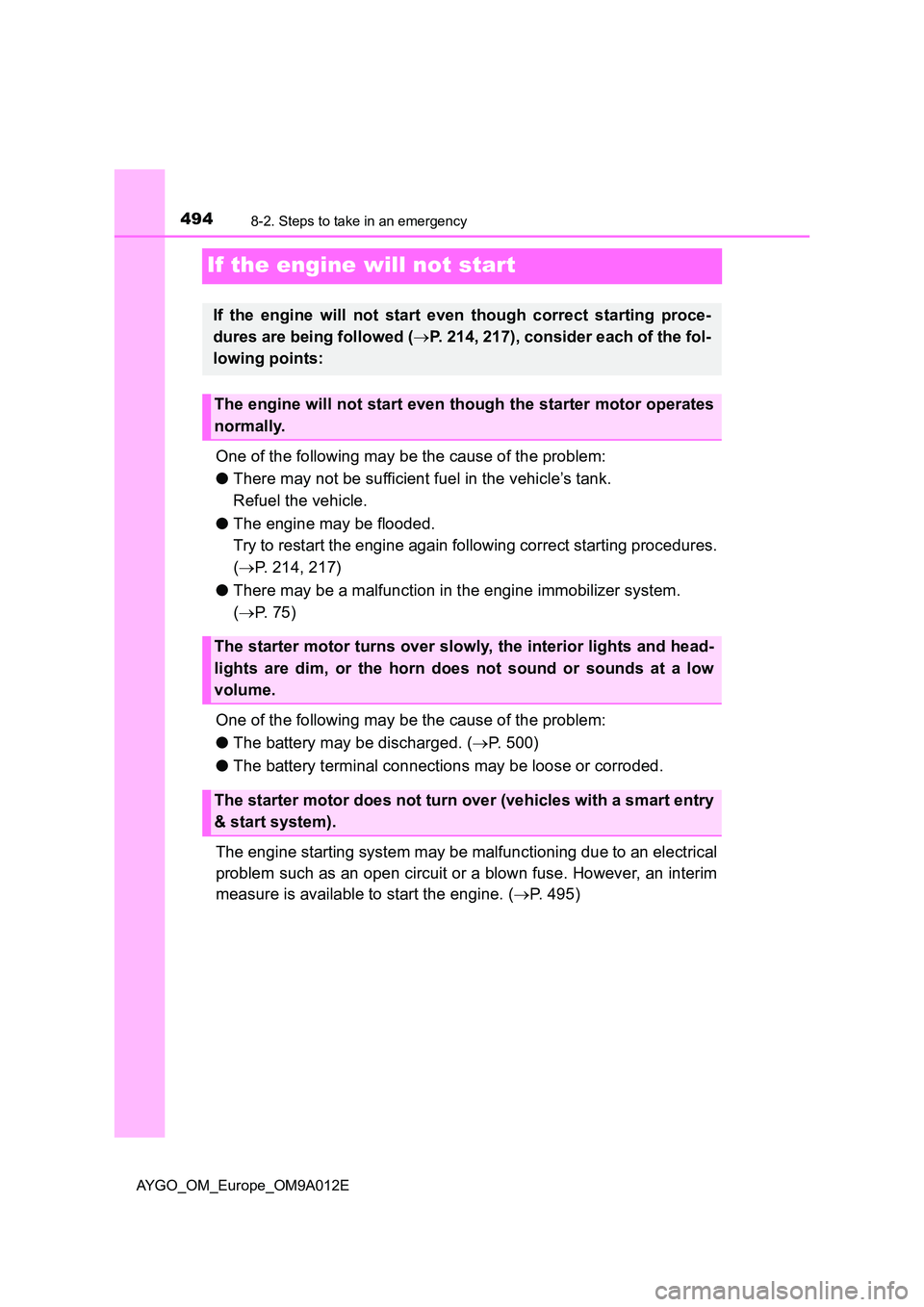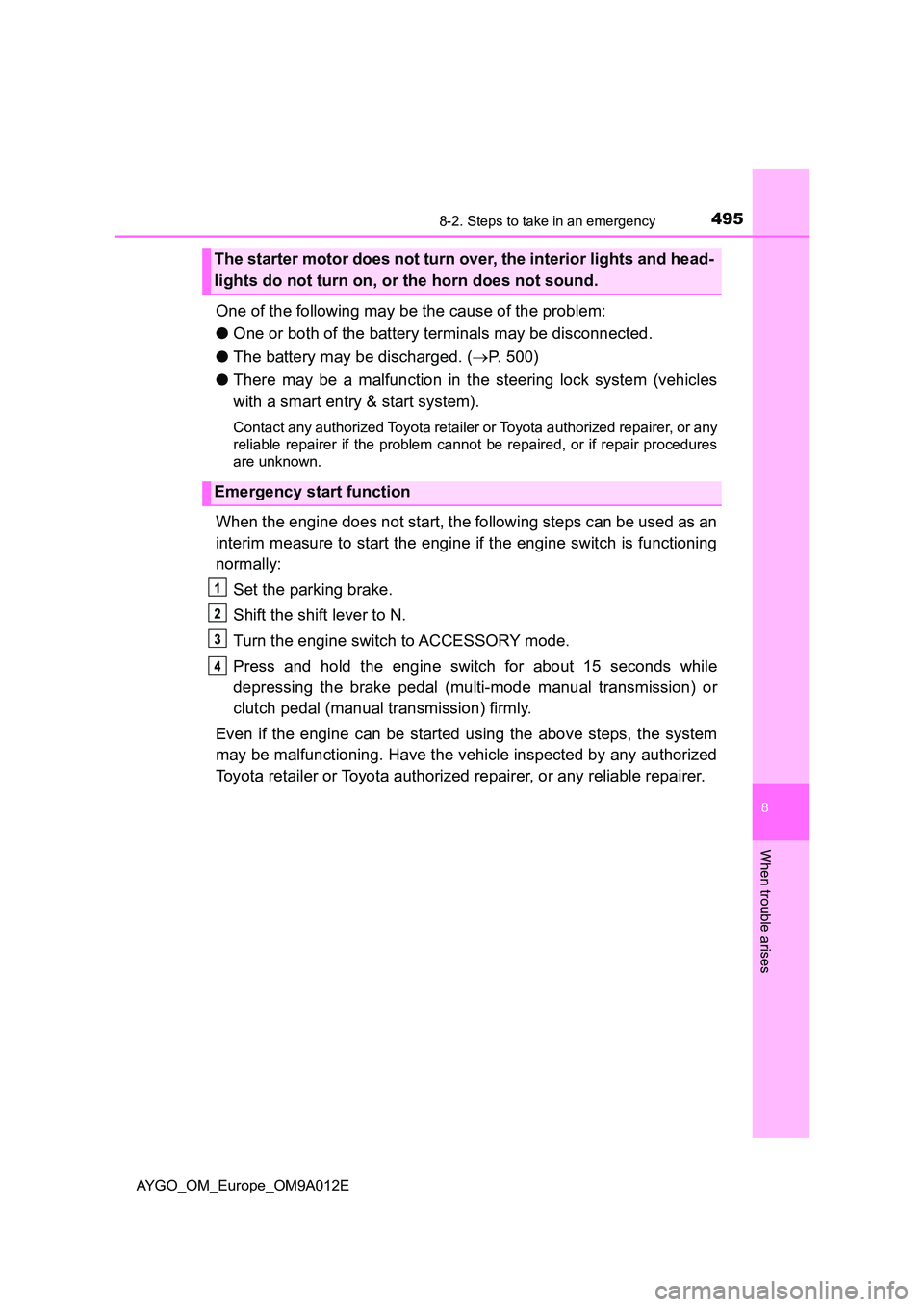Page 462 of 546

4608-2. Steps to take in an emergency
AYGO_OM_Europe_OM9A012E
●Stop the vehicle in a safe place on a hard, flat surface.
● Set the parking brake.
● Shift the shift lever to N.
● Stop the engine.
● Turn on the emergency flashers. (P. 438)
● Check the degree of the tire damage.
A tire should only be repaired with
the emergency tire puncture
repair kit if the damage is caused
by a nail or screw passing through
the tire tread.
• Do not remove the nail or screw
from the tire. Removing the
object may widen the opening
and prevent emergency repair
with the repair kit.
• To avoid sealant leakage, move the vehicle until the area of the
puncture, if known, is positioned at the top of the tire.
■ A flat tire that cannot be repaired with the emergency tire puncture repair
kit
In the following cases, the tire c annot be repaired with the emergency tire
puncture repair kit. Contact any authorized Toyota retailer or Toyota autho-
rized repairer, or any reliable repairer.
● When the tire is damaged due to driving without sufficient air pressure
● When the tire lost air pressure due to a crack or damage in the tire sidewall
● When the tire is visibly separated from the wheel
● When the cut or damage to the tread is 4 mm (0.16 in.) long or more
● When the wheel is damaged
● When two or more tires have been punctured
● When there is more than one hole or cut in the damaged tire
● When the sealant has expired
Before repairing the vehicle
Page 469 of 546
4678-2. Steps to take in an emergency
8
When trouble arises
AYGO_OM_Europe_OM9A012E
Make sure that the compressor
switch is off.
Remove the power plug from
the compressor.
Connect the power plug to the
power outlet socket. ( P. 376)
Check the specified tire inflation
pressure.
Tire inflation pressure is specified
on the label as shown. ( P. 518)
Start the engine. (P. 214, 217)
Page 475 of 546
4738-2. Steps to take in an emergency
8
When trouble arises
AYGO_OM_Europe_OM9A012E
Make sure that the compressor
switch is (off).
Remove the power plug from
the compressor.
Connect the power plug to the
power outlet socket. ( P. 376)
Check the specified tire inflation
pressure.
Tire inflation pressure is specified
on the label as shown. ( P. 518)
Start the engine. (P. 214, 217)
Page 483 of 546
4818-2. Steps to take in an emergency
8
When trouble arises
AYGO_OM_Europe_OM9A012E
If you have a flat tire (vehicles with a spare
tire)
● Stop the vehicle in a safe place on a hard, flat surface.
● Set the parking brake.
● Shift the shift lever to E, M or R (multi-mode manual transmission)
or R (manual transmission).
● Stop the engine.
● Turn on the emergency flashers. (P. 438)
Your vehicle is equipped with a spare tire. The flat tire can be
replaced with the spare tire.
For details about tires: P. 4 0 4
WARNING
■If you have a flat tire
Do not continue driving with a flat tire.
Driving even a short distance with a flat tire can damage the tire and the
wheel beyond repair, which could result in an accident.
Before jacking up the vehicle
Page 485 of 546

4838-2. Steps to take in an emergency
8
When trouble arises
AYGO_OM_Europe_OM9A012E
WARNING
■Using the tire jack
Observe the following precautions.
Improper use of the tire jack may cause the vehicle to suddenly fall off the
jack, leading to death or serious injury.
● Do not use the tire jack for any purpose other than replacing tires or install-
ing and removing tire chains.
● Only use the tire jack that comes with this vehicle for replacing a flat tire.
Do not use it on other vehicles, and do not use other tire jacks for replac-
ing tires on this vehicle.
● Put the jack properly in its jack point.
● Do not put any part of your body under the vehicle while it is supported by
the jack.
● Do not start the engine or drive the vehicle while the vehicle is supported
by the jack.
● Do not raise the vehicle while someone is inside.
● When raising the vehicle, do not put an object on or under the jack.
● Do not raise the vehicle to a height greater than that required to replace
the tire.
● Use a jack stand if it is necessary to get under the vehicle.
● Stop the vehicle on firm, flat and level ground, firmly set the parking brake
and shift the shift lever to E, M or R (multi-mode manual transmission) or R
(manual transmission). Block the wheel diagonally opposite to the one
being changed if necessary.
● When lowering the vehicle, make sure that there is no-one near the vehi-
cle. If there are people nearby, warn them vocally before lowering.
Page 494 of 546

4928-2. Steps to take in an emergency
AYGO_OM_Europe_OM9A012E
WARNING
■When using the compact spare tire
● Remember that the compact spare tire provided is specifically designed
for use with your vehicle. Do not use your compact spare tire on another
vehicle.
● Do not use more than one compact spare tire simultaneously.
● Replace the compact spare tire with a standard tire as soon as possible.
● Avoid sudden acceleration, abrupt steering, sudden braking and shifting
operations that cause sudden engine braking.
■ When the compact spare tire is attached
The vehicle speed may not be correctly detected, and the following systems
may not operate correctly:
• ABS
• Brake assist
• VSC
•TRC
• PCS (Pre-Collision system) (if equipped)
• LDA (Lane Departure Alert) (if equipped)
• EPS
• Tire pressure warning system (if equipped)
■ Speed limit when using the compact spare tire
Do not drive at speeds in excess of 80 km/h (50 mph) when a compact
spare tire is installed on the vehicle.
The compact spare tire is not designed for driving at high speeds. Failure to
observe this precaution may lead to an accident causing death or serious
injury.
■ After using the tools and jack
Before driving, make sure all the tools and jack are securely in place in their
storage location to reduce the possibility of personal injury during a collision
or sudden braking.
■ Replacing a flat tire (vehicles with a steel wheel)
Never use tools, such as an Allen
wrench, that are used by applying them
to a hexagonal concave portion of a bolt
head. Doing so could cause bolt defor-
mation and improper installation, and
may result in serious injury.
Page 496 of 546

4948-2. Steps to take in an emergency
AYGO_OM_Europe_OM9A012E
If the engine will not start
One of the following may be the cause of the problem:
● There may not be sufficient fuel in the vehicle’s tank.
Refuel the vehicle.
● The engine may be flooded.
Try to restart the engine again following correct starting procedures.
( P. 214, 217)
● There may be a malfunction in the engine immobilizer system.
( P. 7 5 )
One of the following may be the cause of the problem:
● The battery may be discharged. (P. 500)
● The battery terminal connections may be loose or corroded.
The engine starting system may be malfunctioning due to an electrical
problem such as an open circuit or a blown fuse. However, an interim
measure is available to start the engine. ( P. 495)
If the engine will not start even though correct starting proce-
dures are being followed ( P. 214, 217), consider each of the fol-
lowing points:
The engine will not start even though the starter motor operates
normally.
The starter motor turns over slowly, the interior lights and head-
lights are dim, or the horn does not sound or sounds at a low
volume.
The starter motor does not turn over (vehicles with a smart entry
& start system).
Page 497 of 546

4958-2. Steps to take in an emergency
8
When trouble arises
AYGO_OM_Europe_OM9A012E
One of the following may be the cause of the problem:
● One or both of the battery terminals may be disconnected.
● The battery may be discharged. (P. 500)
● There may be a malfunction in the steering lock system (vehicles
with a smart entry & start system).
Contact any authorized Toyota retailer or Toyota authorized repairer, or any
reliable repairer if the problem cannot be repaired, or if repair procedures
are unknown.
When the engine does not start, the following steps can be used as an
interim measure to start the engine if the engine switch is functioning
normally:
Set the parking brake.
Shift the shift lever to N.
Turn the engine switch to ACCESSORY mode.
Press and hold the engine switch for about 15 seconds while
depressing the brake pedal (multi-mode manual transmission) or
clutch pedal (manual transmission) firmly.
Even if the engine can be started using the above steps, the system
may be malfunctioning. Have the vehicle inspected by any authorized
Toyota retailer or Toyota authorized repairer, or any reliable repairer.
The starter motor does not turn over, the interior lights and head-
lights do not turn on, or the horn does not sound.
Emergency start function